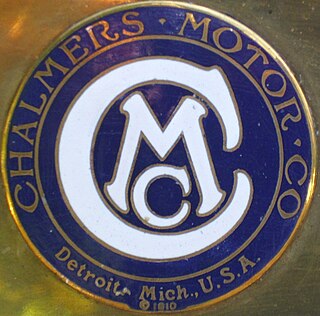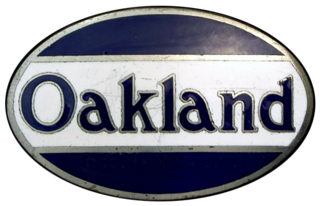
The Chalmers Motor Company was an American automobile manufacturer headquartered in Detroit, Michigan. Founded in 1908 by Hugh Chalmers, the company was known for producing high-end vehicles. Chalmers automobiles gained recognition for their toughness, durability, and engineering receiving particular praise for their performance in touring events. The company reached its peak in 1911, becoming the eighth-largest auto producer in the United States. Despite initial success, the company faced challenges with increasing competition in the auto industry, and sales began to decline in the following years. In 1923, Chalmers Motor Company merged with Maxwell Motor, ultimately forming the basis for the Chrysler Corporation.

Nash Motors Company was an American automobile manufacturer based in Kenosha, Wisconsin from 1916 until 1937. From 1937 through 1954, Nash Motors was the automotive division of the Nash-Kelvinator Corporation. As sales of smaller firms declined after 1950 in the wake of the domestic Big Three automakers advantages in production, distribution, and revenue, Nash merged with Hudson Motors to form American Motors Corporation (AMC). Nash automobile production continued from 1954 through 1957 under AMC.

A sedan or saloon is a passenger car in a three-box configuration with separate compartments for an engine, passengers, and cargo. The first recorded use of sedan in reference to an automobile body occurred in 1912. The name derives from the 17th-century litter known as a sedan chair, a one-person enclosed box with windows and carried by porters. Variations of the sedan style include the close-coupled sedan, club sedan, convertible sedan, fastback sedan, hardtop sedan, notchback sedan, and sedanet/sedanette.

The Brass Era is an American term for the early period of automotive manufacturing, named for the prominent brass fittings used during this time for such features as lights and radiators. It is generally considered to encompass 1896 through 1915, a time when cars were often referred to as horseless carriages.

Touring car and tourer are both terms for open cars. "Touring car" is a style of open car built in the United States which seats four or more people. The style was popular from the early 1900s to the 1930s. The cars used for touring car racing in various series since the 1960s, are unrelated to these early touring cars, despite sharing the same name.

Paul Frère was a racing driver and journalist from Belgium. He participated in eleven World Championship Formula One Grands Prix debuting on 22 June 1952 and achieving one podium finish with a total of eleven championship points. He drove in several non-Championship Formula One races, winning the 1952 Grand Prix des Frontières and 1960 VI South African Grand Prix.

The Oakland Motor Car Company of Pontiac, Michigan, was an American automobile manufacturer and division of General Motors. Purchased by General Motors in 1909, the company continued to produce modestly priced automobiles until 1931 when the brand was dropped in favor of the division's Pontiac make.

Elmore Manufacturing Company was a manufacturer of veteran and brass era automobiles and bicycles (1893–97), headquartered at 504 Amanda Street, Clyde, Ohio, from 1893 until 1912. The company took its name from a small parcel of land in Clyde with the name Elmore associated with it where a stave mill was established originally, then evolved into bicycle production. The village of Elmore, Ohio is located 20 mi (32.2 km) to the east. Founded by Harmon Von Vechten Becker and his two sons, James and Burton, the Elmore used a two-stroke engine design, in straight twin or single-cylinder versions. They later produced a straight-3 followed by a straight-4 beginning in 1906 until production ended in 1912. The company advertising slogan was "The Car That Has No Valves", referring to the two-stroke engine.

Development of the automobile started in 1672 with the invention of the first steam-powered vehicle, which led to the creation of the first steam-powered automobile capable of human transportation, built by Nicolas-Joseph Cugnot in 1769. Inventors began to branch out at the start of the 19th century, creating the de Rivas engine, one of the first internal combustion engines, and an early electric motor. Samuel Brown later tested the first industrially applied internal combustion engine in 1826.

Moon Motor Car Company was an American automobile company that was located in St. Louis, Missouri. The company had a venerable reputation among the buying public, as it was known for fully assembled, easily affordable mid-level cars using high-quality parts. Often this meant the manufacturing process required more human intervention, leading to operating losses. The company was founded by carriage maker Joseph W. Moon. Moon produced both cars and trucks.

Mercer was an American automobile manufacturer from 1909 until 1925. It was notable for its high-performance cars, especially the Type 35 Raceabout.

Scripps-Booth was a United States automobile marque based in Detroit, Michigan. Established by James Scripps Booth in 1913, Scripps-Booth Company produced motor vehicles and was later acquired by General Motors, becoming a division of it, until the brand was discontinued in 1923.

The Buckeye gasoline buggy, also known as the Lambert gasoline buggy, was an 1891 gasoline automobile, the first made in the United States. It was also the first automobile made available for sale in the United States. It was initially a three wheel horseless carriage, propelled by an internal combustion gasoline engine; it was later developed into a four-wheel automobile with a gearless transmission, and mass-produced during the first part of the twentieth century. The platform was later expanded into a line of trucks and fire engines.

Åland is an autonomous and demilitarised region of Finland since 1920 by a decision of the League of Nations. It is the smallest region of Finland by area and population, with a size of 1,580 km2, and a population of 30,129, constituting 0.51% of its land area and 0.54% of its population. Its only official language is Swedish and the capital city is Mariehamn.

Willys was a brand name used by Willys–Overland Motors, an American automobile company, founded by John North Willys. It was best known for its design and production of World War II era and later military jeeps (MBs), as well as civilian versions, and branding the 'jeep' military slang-word into the '(Universal) Jeep' marque.

The Commonwealth Motors Corporation was a luxury auto company that produced cars from 1917 to 1922. The company was founded in Chicago as Partin-Palmer company in 1913, but in 1915 got into financial trouble. So, in 1917, the name was changed to Commonwealth, and production was moved to Joliet, Illinois.

The Chevrolet Series FA of 1917–1918 is an American vehicle manufactured by GM's Chevrolet Division. It was a replacement of the Series F which had improvements in engine capacity as well as other features. In this transformation of series, the pre-existing names of the H and F series cars, The Royal Mail and Baby Grand were dropped in favor of the names Roadster and Touring respectively. The FA Series was then replaced by the Chevrolet Series FB in 1919. Production was not interrupted while the United States entered World War I starting in 1917.

The Chevrolet Series F of 1917 was an American automobile manufactured by Chevrolet before they became a division of General Motors. The successor of the Series H, it had a longer wheelbase and other improvements, but kept the same engine. It was replaced the following year by the Series FA in 1918, which had a larger, more powerful engine. It was sold as the larger alternative to the Chevrolet Series 490, and the Model F was available for US$800 as either a roadster or touring sedan. As the Model F and Series 490 were in direct competition with the Ford Model T, sales were recorded at 110,839 for Chevrolet, with 57,692 Series 490 and 3,493 Model F. Chevrolet instituted Knock-down kit assembly where the product was created at Flint Assembly, then shipped by rail to the branch locations and locally assembled using locally sourced items such as tires, glass and other items. In 1917, the Monroe Motor Company was sold to William Small of Flint MI and was no longer sold by independent Chevrolet dealers when they weren't part of GM. Mason Motor Company was merged into Chevrolet once it became a division of GM and was used to supply engines for GM-Chevrolet vehicles.

The Clydesdale Motor Truck Company was a motor company that existed from 1917 to 1939 with headquarters in Clyde, Ohio. Initially, they made military trucks for World War I. Military contracts continued to be a large part of their business after the war, but they also sold into many other markets: general haulage, farming, and specialized vehicles such as fire trucks. They survived the Wall Street Crash of 1929 and the Great Depression, but increasingly struggling, they were wound up in 1939.

















